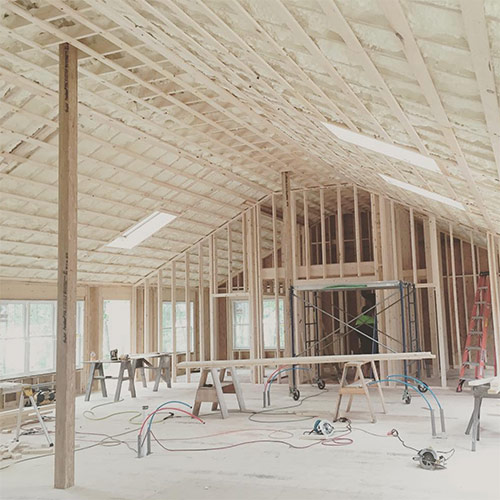Maine residents want energy-efficient and comfortable homes, but is it reasonable to have too much insulation?
Insulation is vital for regulating temperature, especially during summer and winter, but knowing the right amount for each home can be challenging. Understanding how much of it is necessary is essential, as adding excess insulation might lead to diminishing returns and potential environmental implications.
In this post, we’ll explain the consequences of having too much insulation, consider the diminishing returns on added value, discuss environmental implications, and address mold risks in cavity walls with excessive layers of material. By the end, you’ll have a clear understanding of how to achieve optimal insulation levels for maximum efficiency in your Maine residence!
Is Too Much Insulation a Bad Thing?
Insulation is an essential component in keeping our homes energy-efficient. It prevents heat from escaping during winters while keeping the spaces cool during summers. However, there’s a common misconception that more insulation always translates to better efficiency. This leads to the problem of excessive insulation, which can result in diminishing returns.
So, yes, too much insulation is a bad thing.
When Maine homeowners invest in insulation beyond the recommended levels, they might expect significant energy savings. However, they often overlook the fact that beyond a certain point, the additional insulation doesn’t yield the expected benefits. Instead, it can lead to increased installation costs without offering substantial improvements in energy efficiency.
To avoid this, homeowners must be well-informed about the recommended levels of insulation for their specific needs. By conducting an energy audit or seeking professional advice, you can determine the optimal insulation requirements for your home. This way, you can strike the right balance between efficiency and cost-effectiveness, ensuring you get the most value from your insulation investment.
Mold in the Middle: Protecting Your Home from Moisture Damage
While home insulation is vital for maintaining comfortable indoor temperatures and reducing energy costs, homeowners must be cautious not to over-insulate.
Improper insulation practices can lead to the growth of mold and mildew. This is particularly concerning when homeowners apply spray foam insulation excessively, creating an unintended trap for moisture, leading to property damage, unpleasant odors, and even respiratory issues.
Proper ventilation is the key to avoiding moisture buildup and mold growth. Homeowners should ensure their homes have adequate ventilation systems that allow moisture to escape and maintain a healthy indoor environment.
Additionally, they should be cautious when applying insulation like spray foam and consider professional installation to prevent over-insulation and subsequent mold issues.
When You Shouldn’t Insulate: Knowing What to Avoid
Insulating a home is generally beneficial, especially in energy efficiency, but there are specific situations where insulation can do more harm than good. Many homeowners might not be aware of the potential risks associated with insulating in certain conditions.
Some homeowners may attempt to insulate their homes without considering existing issues like mold, excessive moisture, or poor air quality. By doing so, they worsen these problems and end up with costly repairs and potential health hazards.
Before insulating, homeowners should:
- Thoroughly assess your home for any existing issues.
- Address problems like mold or moisture before adding insulation to prevent further complications.
- Consider hiring a professional to evaluate ventilation needs and ensure that insulating the home is a suitable and beneficial course of action.
The Benefits of Ventilation: Reducing Humidity and Controlling Temperature
Proper ventilation is often overlooked when discussing home insulation, leading to issues like high humidity levels and inadequate temperature control.
By reducing humidity levels, adequate ventilation helps prevent the growth of mold, mildew, and other harmful bacteria that can negatively impact air quality and human health.
Investing in proper ventilation systems helps maintain healthy humidity levels and enables better temperature control throughout the home. This not only improves indoor air quality, but also enhances the overall comfort and energy efficiency of the living space by removing unpleasant odors, smoke, and air pollutants.
Maximizing Efficiency: Tips for Installing the Right Amount of Insulation
Homeowners may not realize the impact of proper insulation on energy efficiency, leading to suboptimal insulation choices and increased energy bills. Both under-insulation and over-insulation can lead to inefficient energy use and reduced comfort.
Homeowners should consider factors such as climate, insulation material, and the insulated area. Consulting professionals or conducting an energy audit can help determine the appropriate amount of insulation required to maximize efficiency, reduce energy bills, and create a comfortable living environment.
In a nutshell, insulation is a real game-changer in safeguarding your home from air loss and reducing energy costs. While it’s possible to have too much insulation, understanding how insulation works and taking a few precautionary measures can save the day.
Weighing the potential risks of mold heightening humidity levels and environmental concerns with proper ventilation will help to ensure that you’re maximizing efficiency while minimizing any potential damages. Get the insulation right to maintain a healthy temperature while managing energy costs!
If you’re ready to learn whether your home is ready for insulation (and prepare for the hot summer and cold winter ahead), get a free quote from Seal It Insulation Systems today!











